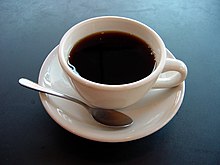cà phê
Vietnamese
Etymology
Adapted from an earlier form trà phê (“coffee”) (Martini, 1958; Michaud et al., 2015), as attested in scholar Pétrus Ky's Cours d'annamite parlé (1894). This is a phono-semantic matching of French café (“coffee”), matching the first syllable with the existing Sino-Vietnamese word trà (“tea”); literally, this name could be interpreted as: “a kind of tea with the phê attribute” (whatever that attribute may mean).
Naming coffee as a type of tea acclimatises the new beverage, introducing it into a set that already included trà tàu (“Chinese tea (black tea)”), trà Huế (“Annamese tea (green tea)”), trà hoa (“camellia tea”), trà rừng (“three-seeded mercury (herbal) tea”), and so on (Martini, 1958; Michaud et al., 2015). An example is found in Cours d'annamite parlé:
- anh uống trà-phe hay-là trà-tàu
- Do you drink coffee or tea ?
Later on, the form trà phê underwent re-foreignisation, influenced by French-speaking Vietnamese who pronounce French café as ‹ca phê› (Michaud et al., 2015). A hybrid form of cà phê emerged as a consequence, retaining the original /k/ in the donor language and the tone of trà, and this form eventually became the standard (Nguyễn, 1999).
An alternative theory for the unexpected tone on cà was put forth by Emeneau (1951: 4, 158), who tentatively proposed that it was due to association with cà (“eggplant”), in a fashion similar to cà rốt (“carrot”). However, this is now deemed to be very unlikely.
Compare phê (“high; intoxicated”), as well as Cantonese 咖啡 (gaa3 fe1, also with a lower tone on the first syllable).
Pronunciation

Noun
- coffee
- cà phê có liền ― instant coffee
- cà phê dùng ngay ― instant coffee
- cà phê hòa tan - instant coffee
- cà phê nồi ― coffee pot
- máy xay cà phê ― coffee grinder
- tiệm cà phê ― café
Derived terms
- cà phê đá (“iced coffee”)
- cà phê đen (“black coffee”)
- cà phê phin (“Vietnamese coffee filter/percolator”)
- cà phê sữa đá (“iced coffee with milk”)
- cà phê sữa (“coffee with milk”)
- cà phê trứng (“egg coffee”)
- quán cà phê (“coffee shop; coffee bar; coffee house; café”)
References
- Emeneau, Murray Barnson (1951). Studies in Vietnamese (Annamese) grammar. University of California Publications in Linguistics. Berkeley: University of California Press.
- Martini, François (1958). Notices bibliographiques - langue vietnamienne: Emeneau, Studies in Vietnamese (Annamese) Grammar, et Lê Văn Lý, Le parler vietnamien . Bulletin de l’Ecole Française d’Extrême-Orient 49. 337–348.
- Michaud, Alexis; Ferlus, Michel, Nguyễn, Minh-Châu (2015). “Strata of standardization: the Phong Nha dialect of Vietnamese (Quảng Bình Province) in historical perspective”. Linguistics of the Tibeto-Burman Area, Dept. of Linguistics, University of California, 38 (1), pp. 124–162.
- Nguyễn Đình-Hòa (1997). Tiếng Việt không son phấn. Volume 9 of London Oriental and African language library. John Benjamins Publishing. pp. 39.
- Nguyễn Như Ý (1999). Đại từ điển tiếng Việt . Hanoi: NXB văn hoá-thông tin.
- Pétrus Trương Vĩnh Ký (1894), Cours d'annamite parlé (vulgaire), Saigon, pp. 178.
